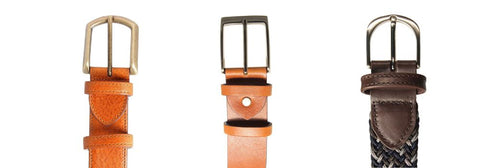A Guide to Quality Belts with Italian Artisanal Precision
Share
When it comes to choosing a quality belt, the wisdom shared among chefs – prioritizing the quality of a few key ingredients – resonates profoundly. At 72 Smalldive, our decision to entrust the production of our belts to Italian artisans is driven by their deliberate and meticulous approach to crafting accessories.
Whether a belt is meant for a casual outfit or formal wear, we strongly advise our customers to opt for only high-quality options. While belts are often viewed as disposable fashion items, we discourage such a mindset. A poorly made belt not only fails to enhance your outfit but also undermines its purpose to elevate and accentuate your style. A truly good quality leather belt should exhibit the following features.
Italian Tanneries Provenance

Italy has been a prominent producer of leather products since the 12th century, boasting unparalleled expertise in tanning and treating leather. Today, Italy not only houses excellent leather tanneries but also those that adhere to strict regulations outlined in the European REACH Directive. Choosing a belt made from leather of Italian tannery provenance demonstrates a commitment to premium materials and minimizes the environmental impact of its production.
The Foundation Of A Quality Strap

For both formal and casual wear, the essence of a quality belt lies in its strap. A top-notch belt should be crafted from premium materials, particularly top-grain or full-grain calf leather. Ideally, these leather straps should be tanned with water-based dye to render a supple texture. Unlike belts made from split leather, which tends to peel away with use and exposure to humidity, those made from top-grain or full-grain leather, with proper care, can last over four years.
However, a good quality casual belt doesn't necessarily have to be exclusively made from premium leather. Intentional and meticulous production steps can render less premium leather, such as bonded leather, more durable. Bonded regenerated leather, crafted from leather trimmings and protected with water-based fixant, woven in a tubular structure, can serve as a highly durable strap for braided belts.
The Allure of Brass Buckles

A belt is only as strong as its buckle, and Italian artisans comprehend this well. Solid brass, the second-hardest metal after stainless steel, is the preferred choice for belt buckles due to its durability and resistance to dents. Unlike hollow alternatives, solid brass buckles ensure a lasting holdfast, embodying the essence of a well-crafted and high-quality belt.
Meticulous Detailing: Layers of Excellence
Beneath the seemingly simple exterior of a belt lies a laborious crafting process, invisible to many customers. Belts, crafted with meticulous detail, typically consist of three layers: a full-grain or top-grain leather upper layer, a nubuck leather lining, and a slim inlet layer known as "anima" in Italian. This layering not only enhances durability but also provides a distinctive raised look and a refined appearance.
Quiet Luxurious Details: Stitching, Alignment, and Edge Finishing
Other indicators of quality lie in the silent details such as tight stitching to ensure durability, perfect alignment of leather, lining, and buckle, and flawless edge finishing. All of these details reflect the artisan's attention to detail. These characteristics, inherent in handmade products, make the Italian artisanal approach to belt making truly unparalleled.
Commitment To Artisanship
It is for these very reasons that we choose Italian artisans to craft our belts. These artisans uphold a level of finesse that surpasses mass-produced counterparts. Their commitment to excellence is evident in every aspect, from fine finishing to intricate layering. In a world where mass production often sacrifices tradition, precision, and quality, Italian artisans stand as guardians of the art, ensuring that each belt is not just an accessory but a masterpiece of timeless elegance – each belt is a testament to steadfast dedication to tradition, precision, and uncompromising quality.